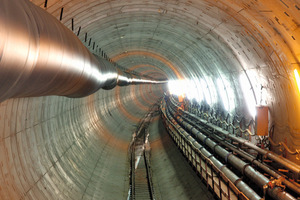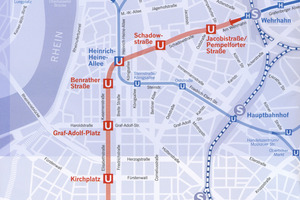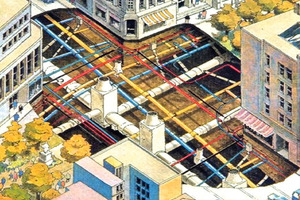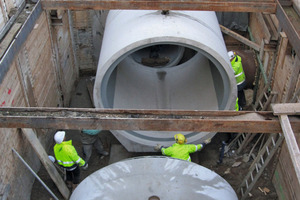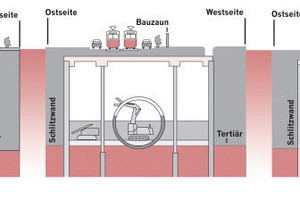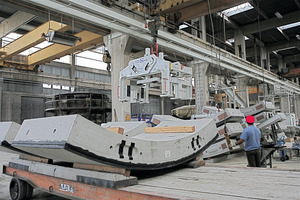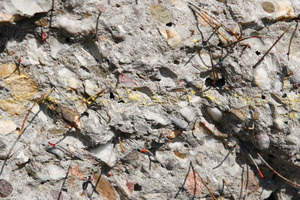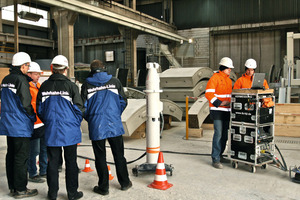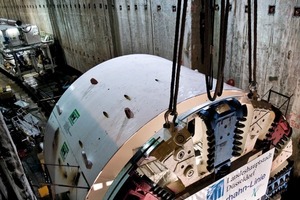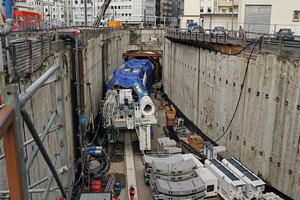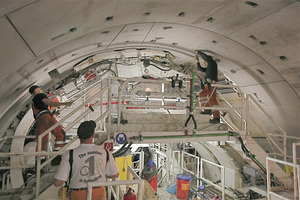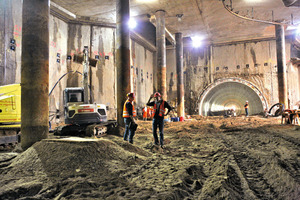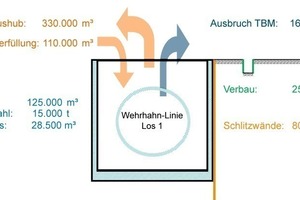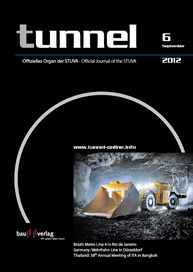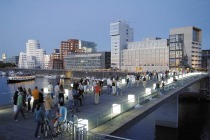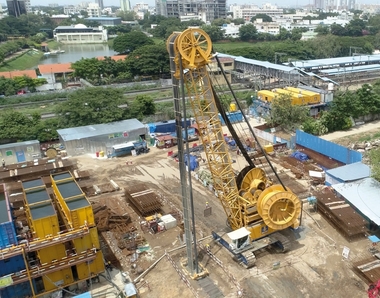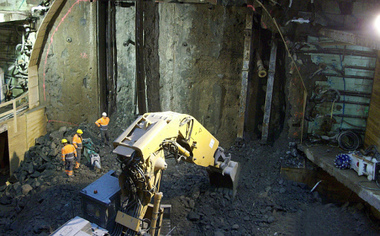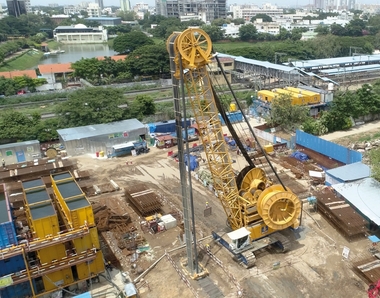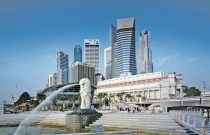Metro Construction in the Focus of the City
The regional capital of Düsseldorf, highly rated among the cities affording the greatest life quality, is engaged in setting further standards in terms of urban design and infrastructure. Two major construction projects in a vibrant city involving an invested volume of more than 1 billion euros are no everyday occurrences even for a place the size of Düsseldorf. The new Metro Wehrhahn Line and the Kö-Bogen area will sustainably place their stamp on an ever growing metropolis. The target of the first stage of the construction programme has been reached according to schedule: the completion of the 3.4 km long tunnel, which is the main topic dealt with in this report.
Düsseldorf has more than 580,000 inhabitants. More than 450,000 people find employment in the various branches of industry and commerce. It is essential to optimise private motoring and public commuter transportation to ensure that the city remains attractive for business. With the slogan “More Mobility – more Urban Quality” the new Metro line augments the existing transit network catering for an efficient link between the eastern and western parts of the city. The construction costs amount to a total of some 748 million euros including planning costs and land acquisition. Through combining technologies, architectural and artistic concepts, the Wehrhahn Line is destined to set standards making it one of Europe’s most modern and user-friendly Metro lines. After all no less than 50,000 passengers are expected to use the facility on a daily basis, who will arrive at their destinations faster and more comfortably thanks to the scrapping of 5 tram lines.
The Metro route undercuts downtown Düsseldorf – an extremely critical area for residents, business people and the traffic set-up. Undertunnelling a city centre over several kilometres as well as the construction of 6 new underground stations are projects, which do not go unnoticed by the citizens who are affected. Well before the individual planning phases began right up until the first clod of earth was turned the Office for Transport Management responsible for the entire project had recognised the necessity and established a “pro-active dialogue” under the motto “acting rather than reacting” with all those affected by the construction scheme. Towards this end solutions compatible with the environment were sought in order to accomplish the construction measures. The priority was to protect those affected from excessive restrictions and to maintain the entire traffic set-up for private and public transportation as far as possible throughout the construction process. As a consequence it was essential to concentrate on construction methods, which were mainly carried out underground and which had already proved their worth during the building of previous Metro lines in Düsseldorf: shield driving for the route and the “Düsseldorf dig-and-cast method” for the 6 new stations.
Difficult Laying of Utilities prior to Constructing the Metro
Before the actual tunnelling began planners and utility line contractors had to accomplish a sophisticated underground infrastructure measure: the laying and upgrading of the dense and sensitive line network in the downtown area without causing major hindrances to traffic above all in the pedestrian zones. At some spots complete sections of sewers had to make way for the Metro or be relocated from their original position in the middle of the road to along house fronts. Towards this end extensive underpinning work was necessary at the adjoining buildings mainly using the jet grouting method. Some 4 km of water and sewer lines were produced. A whole range of pipes varying between 300 and 2,200 mm in diameter was applied. With the lines for electricity, water, gas, district heating etc. that had to be laid, the grand total amounted to 100 km. This accounted for a major portion of the overall performance.
Environmentally-friendly Construction Methods particularly sought for Tunnelling
The age of tunnelling in Düsseldorf began as far back as 1958/59 when the sewers of the parts of the city on the right bank of the Rhine had to be linked with the clarification plant on the left bank beneath the river. A trail-blazing enterprise: the city fathers decided to have the necessary tunnel produced using a compressed air shield drive, an environmentally-friendly method, which had never before been applied in Germany. Metro construction has forged ahead in the regional capital for more than 4 decades. Tunnels totalling in excess of 7 km have been built.
To construct the new Metro route an effort was made at the planning stage to restrict the effects of the construction work in the middle of an extremely busy downtown area to a minimum. The underground shield drive, which was applied successfully for former route sections, emerged as the sole sensible and also economically viable alternative and was made use of along the entire route in modified form. A part-section that was built in advance more than 30 years ago led to the tunnel being created in 2 sections.
Temporary construction pits were required only at the 6 new stations, 5 of which were produced by dig-and-cast. The graphic diagram shows the procedure: firstly diaphragm walls are set up in a longitudinal direction, then the top section of the future station is built, under which the further construction activities take place. Traffic in then conducted past the site so that it can continue to flow. In this way restrictions are confined to a minimum. Subsequently the stations are developed entirely underground. Project-specific demands had to be fulfilled and progressive construction techniques applied efficiently for driving and supporting the tunnel. As a result tunnellers and construction material technologists were called on to develop new know-how and innovative concrete cast parts.
Tunnel Segments with utmost Precision
The DW-Werk Nievenheim of the Berding Beton GmbH possesses long-standing experience in producing high-quality reinforced concrete cast parts quite apart from a highly-efficient modern production line for reinforced concrete segments. This is why it was commissioned by the Bilfinger Berger Ingenieurbau GmbH as general contractor to produce the reinforced concrete segments for lining the tunnel bores. They possess an external diameter of 9.20 m. Each tunnel ring consists of 7+1 segments, each weighing 6.6 t. An entire ring weighs 46.2 t. Altogether 12,144 individual elements were produced – resulting in a total of 1,518 rings for the 2 construction sections. The concrete rings were produced with a conic form.
Innovative Steel Fibre Technology successfully applied
The segments in the station areas comprise a steel fibre concrete, which facilitated precision down to tenths of a millimetre in conjunction with a special shuttering method. Towards this end, a special multi-tested concrete recipe as well as the utmost accuracy during the production process was essential. A report provided by the Bilfinger Berger Ingenieurbau (by Dipl.-Ing. Lars Bayer and Dipl.-Ing. Markus Brack) supplied invaluable findings, which can by and large be summed up as follows:
• The manifold possibilities for applying concrete can be considerably extended by using fibres especially steel fibres in the mix. This now also applies for segments, thus opening up an interesting market sector.
• Steel fibres included and evenly distributed in the concrete mix improve the properties by counteracting crack formation as 3-dimensional evenly distributed reinforcement and resist the tendency for cracks to expand. The crack edges are connected by the steel fibres. In this way residual bearing capacity is assured even in cracked state.
• Furthermore steel fibre concrete represents an economic alternative, which is not only technically on par with conventional concrete but is in many respects superior. Thanks to the uniform distribution of the fibres, steel fibre concrete is capable of sustaining bending and tensile forces in any desired direction as a homogeneous and isotropic construction material. A further substantial advantage is the straightforward means of production. There is no need for complicated working steps involving producing, transporting and installing reinforcing cages.
• Steel fibre concrete segments were temporarily applied for all 4 stations crossed by TBM and dimensioned for a period of use lasting 3 years in accordance with the new German Guideline on Steel Fibre Concrete. Based on the estimated performance class, a Dramix Steel Fibre RC-80/60-BN was proposed by Bekaert and confirmed through tests in the company’s own lab. Further tests took place at Bilfinger Berger and in the DW-Werk Nievenheim. After these tests revealed positive results, further trials were carried out at the TU Brunswick and the Institute for Construction Materials, Massive Construction and Fire Protection. These tests formed the basis for approval in each individual case and were included in a quality assurance plan especially developed for this construction scheme. The extremely good results obtained during the lab tests were confirmed by hardened concrete tests on the structure.
• Following the introduction of the new Guideline on Steel Fibre Concrete in practice, innovative applications of steel fibre concrete – in general use worldwide now for years – should also be applied increasingly in Germany. However a lot of clarification and catching up is still essential in this respect. Details relating to verifying the stability of steel fibre reinforced concrete were dealt with at length by Dipl.-Ing. Max Kemmler (Bilfinger Berger Ingenieurbau) in the jubilee publication “Past meets Future – 50 Years of STUVA”. This led among others things to the conclusion “that verification of the ductile structural behaviour according to DIN 1045-1 as well as verification of any shortfall of the system bearing load can be provided with only slight alterations to the static system and without major time and effort”.
“Tuborine” produced Metro Lot in Record Time
The hydro-shield method was applied in Düsseldorf to excavate the soil and support the face. The approx. 2.3 km long drive was split into the individual contract sections south and est. The 1,298 m long south section mainly runs beneath the public road area, the 995 m long east drive partially underneath existing buildings and beneath public roadways. The shield passed through the station areas. At this time point the diaphragm wall construction pit enclosures and the station top covers were already completed although the pit still had to be excavated and the groundwater lowered. Then the temporary tunnel segments were removed within the station sections and the roughwork for the stations could be tackled.
The Herrenknecht Mixshield S-491 TBM, christened “Tuborine” by a Düsseldorf lady resident, was devised especially for the Metro Wehrhahn Line: a giant among tunnelling machine weighing 1,302 t and 65 m long with 9.50 m cutting wheel diameter. The 115 t heavy cutting wheel that loosened the soil was located at the front of the cutterhead. The cutterhead penetrated the soil with the cutting wheel. Once the tunnel boring machine had started operating, an extensive data system provided an insight at any time via display of the individual data, the steering, rpm, torque and the potency of the cutting wheel. The TBM, which removed the in situ soil along the route between the stations, also possessed the power to cut open circularly the 80 to 120 cm thick concrete diaphragm and sealing walls, which had previously surrounded the stations. In order to go easy on the wheel, glass fibre reinforcements were used in these walls. A slurry suspension supported the soil in front of the cutting wheel; it then mixed with the soil and was pumped out of the tunnel via the discharge line. A separation plant was located at the starting pit, in which the slurry suspension was separated from the excavated material and pumped back to the cutterhead.
Protected by the shield machine the tunnel was produced ring-by-ring with a monocoque segmental lining. The shield machine supported itself on the last completed ring for the drive and advanced by the length of a ring (1.50 m in the case of the Wehrhahn Line) with the soil being removed simultaneously. The annular gap between the outer edge of the segment and the surrounding soil was grouted with mortar. Tracks were laid right up the machine for transporting the segments in the tunnel. Two trains were available for carrying material and crew. The silos with dry material used for mixing the mortar that was pressed into the soil around the rings were located at the end of the starting shaft.
The site installation and logistics were also geared to urban requirements. In order to cut down on noise, dirt and transporting soil within the city centre around the second starting shaft directly sited on the prestigious “Kö” shopping street as well as for reasons of space, the separation plant also remained on the southern central site installation for the second drive, which incidentally has a good link to the motorway for transporting excavated material and segments.
The Tuborine’s rate of advance was impressive: it amounted to between 9 and (mainly) 14 m/day depending on the degree of difficulty. In less than 7 months a well coordinated team was able to successfully accomplish the first driving stage after tunnelling 1,298 m. The scheduled period for the second section of driving – 985 m - was more or less adhered to in spite of a number of previously unknown obstacles affecting the tunnel – an outcome which pleased both the client as well as first and foremost those responsible at Bilfinger Berger Ingenieurbau, who were able to praise their 60-strong team for an outstanding performance. A lack of accidents was an amazing achievement quite apart from the fact that no settlements worth mentioning occurred along the entire route when tunnelling.
Practised Partnership: the Basis for good Results
If a construction scheme is concluded with a thoroughly positive outcome, there is good reason for it. The client, the Office for Transport Management of the Regional Capital of Düsseldorf, was successful from the start of a lengthy planning phase in gradually integrating those involved either directly or indirectly in the project within the Wehrhahn Line team. Above all, the many people representing the interests of authorities and organisations from the transport and supply branches rapidly recognised the advantages of honest, trustful collaboration in a spirit of partnership backed up when possible by personal encounters. The icing on the cake: a transparent and honest exchange of views with the residents of Düsseldorf, which were at all times informed in an understandable manner throughout the development and execution of the project. This was frequently accomplished during scheduled sessions with citizens at which objections could be allayed and wishes taken into consideration. Furthermore meetings with client representatives and planners were held on site so that matters could be discussed openly and put into perspective without a costly project such as the Wehrhahn Line of such importance for the city and its inhabitants being blocked directly.
Just how important it is to arrive at a positive dialogue with responsible citizens has unfortunately been experienced of late in the case of comparable major projects – unfortunately because a lack of communication often ultimately led to unpleasant scheduling and financing problems and it was simply not possible to include the general public in the necessary discussions. Nowadays to an ever increasing extent Düsseldorf residents and the local media refer to “our” rather than the “Wehrhahn Line” underlying that things can work out differently and just how essential honest, sustainable communication work is, work which however should not first begin once a project is completed.

